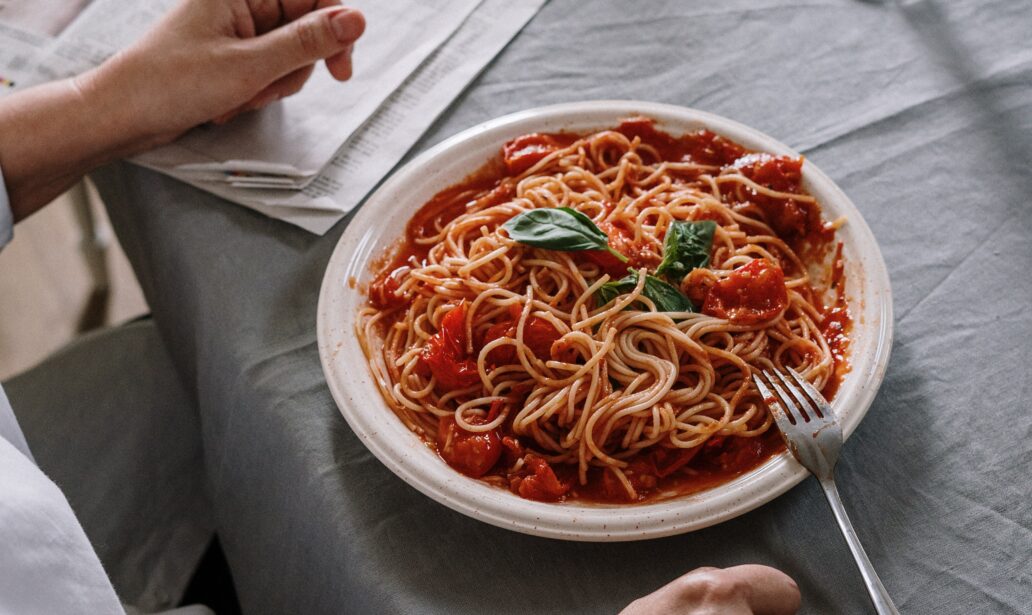I do not eat pasta anymore. Let that sink in. A world without pasta when growing up, pasta was dinner at least 3 nights a week. Italian food in general is my favorite cuisine. I grew up in an Italian-American (and Polish) household, so carbs were the answer. Pasta, bread, and pierogi are what made me, me. But those days are long gone and here I am, telling myself zoodles are filling. All jokes aside, as much as pasta is amazing, I have always been a huge fan of vegetables. And I feel better after eating zoodles than noodles. It is what it is.
Topping your zasta is more important than what you use for the noodle itself, and boy do I have the sauce for you. I almost contemplated not posting this recipe to just keep it for myself, but that’s not fun. There are tons of secrets to great marinara sauce out there, but mine is the best. Marinara is all about balancing out the acidity of the tomatoes. And canned tomatoes are readily available to most regions, so anyone at any time can make this sauce.
Let’s talk balsamic. It is my favorite vinegar in the world. If I am making a homemade dressing, balsamic is in it. I just love the thick, almost prune-like sweetness that is unique to only balsamic. I use this stuff in so many dishes and keep a large container on-hand at all times.
For those in the Midwest US, the Union Pier farmer’s market in South Michigan has the best balsamic vinegar vendor ever. His best (and most expensive) kind is a 10-year aged balsamic, which is what I typically purchase. It is worth every penny. If the farmer’s market near you does not carry balsamic, just get one at the grocery store. Be sure it is aged for optimal flavor.
And now, for the marinara. Chop and drop some onions into a pan with some olive oil. In order to get the deepest, most complex flavor, cook your onions for a while. I’m talking 30 minutes over low heat. Why? Because the slower you caramelize the onions, the better flavor they will lend to the sauce. Add garlic, quality dried Herbes de Provence, and sweet white wine.
Sweet white wine?! That’s right. Instead of adding sugar, my other secret to perfect marinara is using a sweet wine to balance the acidity of the tomatoes. I use Riesling, and it adds the perfect amount of sweetness for canned tomatoes. Let the wine cook out before adding the tomatoes and balsamic. Allow the sauce to cook for at least 2 hours total, longer if you have the time. Over the hours, the sauce caramelizes in the pan and will turn a dark red color. This is flavor, and this is what you want!
Serve with whatever you like to eat with marinara. Continue to read below for the full recipe!
The Best Balsamic Marinara
Ingredients
- 1/2 sweet onion, chopped finely
- 1/4 cup olive oil
- 5 garlic cloves, minced
- 2 tsp dried Herbes de Provence
- 2 tbsp sweet white wine, I like Riesling
- 1 16 oz. can tomato puree, preferably imported from Italy
- 1 large bunch basil, left whole
- 1 tbsp balsamic vinegar, aged if possible
- 2 tsp salt
- 1 tsp freshly ground black pepper
Instructions
- Begin by chopping your onions. Put a large pot on medium heat with the olive oil. Add onions and cook, lowering the heat if onions brown too quickly. We are just looking to sweat the onions, not brown them.
- Continue cooking the onions, lowering the heat and to allow deep caramelization to happen in the pan. The longer you cook your onions, the more depth the sauce will have. Sauté the onions for a minimum of 20 minutes, preferably 30 minutes.
- Once the onions have taken on a deeper color and are very soft, add the garlic and dried herbs. Cook for 1 minute, until the garlic is very fragrant.
- Turn your heat to the lowest setting. Add your wine and allow to simmer and cook down for 2 minutes, stirring constantly. Once evaporated, add your tomato puree. Stir to combine.
- Once the mixture is homogenous, you can lay your basil leaves in. I leave them whole so I can pick out the whole thing later. Add balsamic, salt, and pepper. Bring the heat back up to medium-low and continue to cook, stirring occasionally, for about 2 hours or until the sauce has deepened in color and has thickened.
- When done, taste and adjust for seasoning at this stage. Discard the whole, now blackened basil leaves.
- Serve as a dipping sauce, over zoodles, or put it on pizza.


Great ingredients and looks so good!